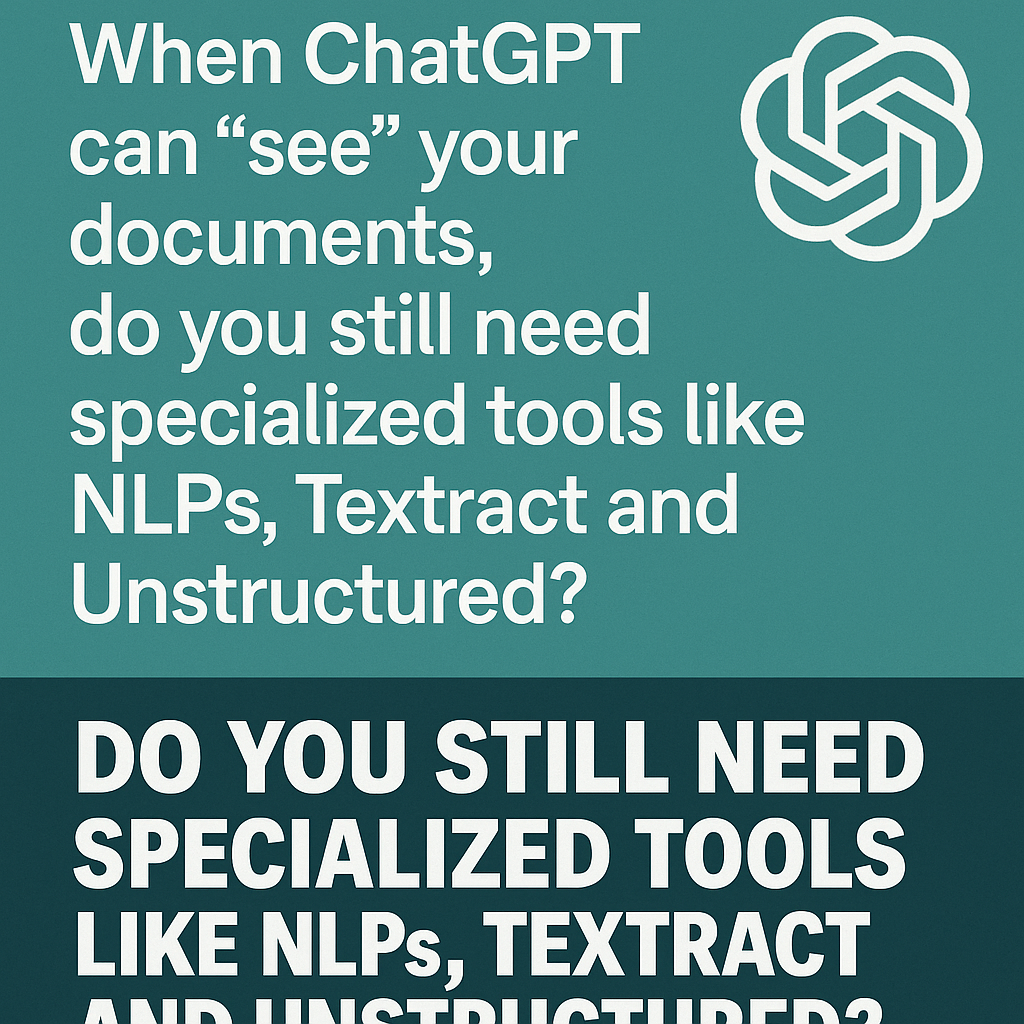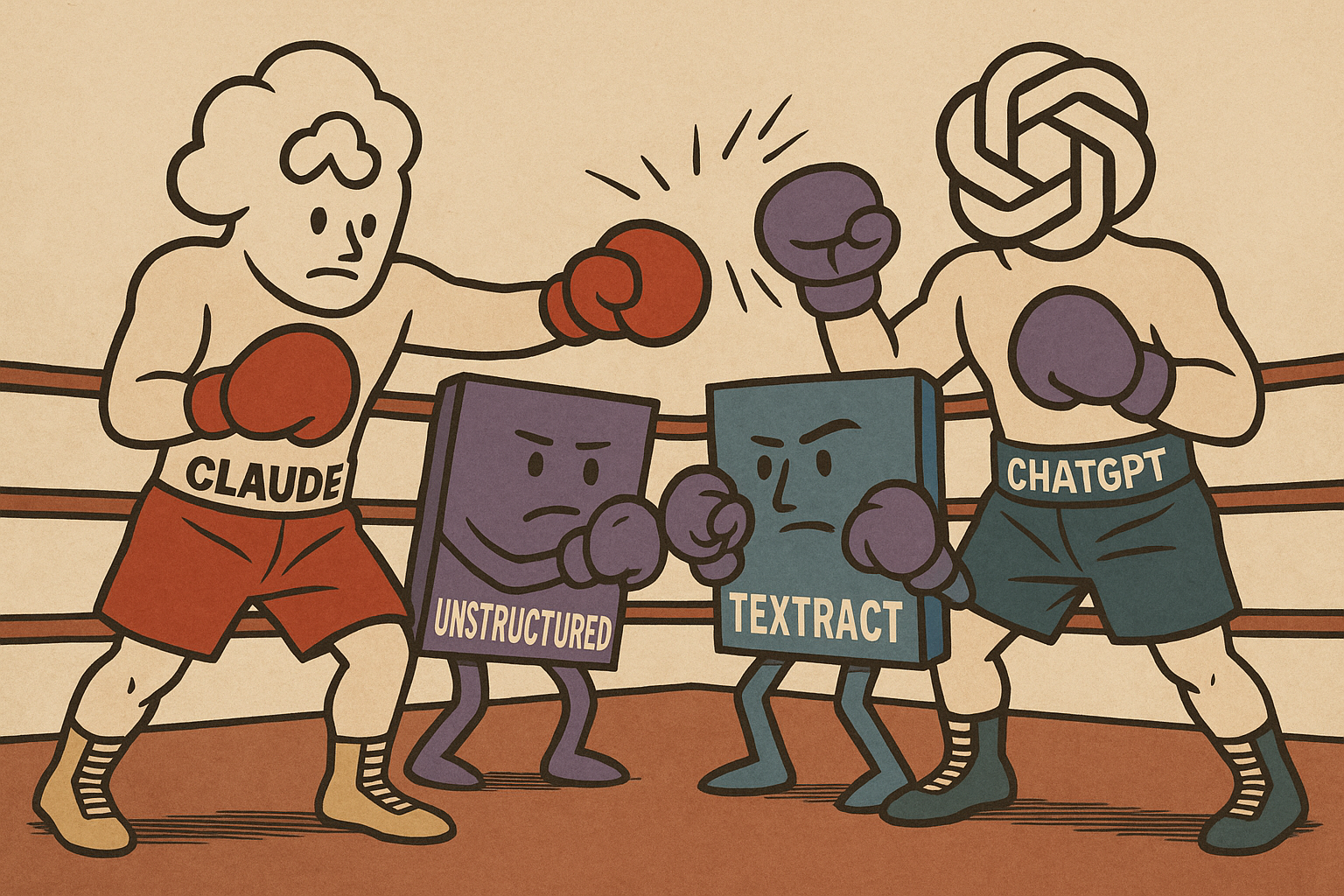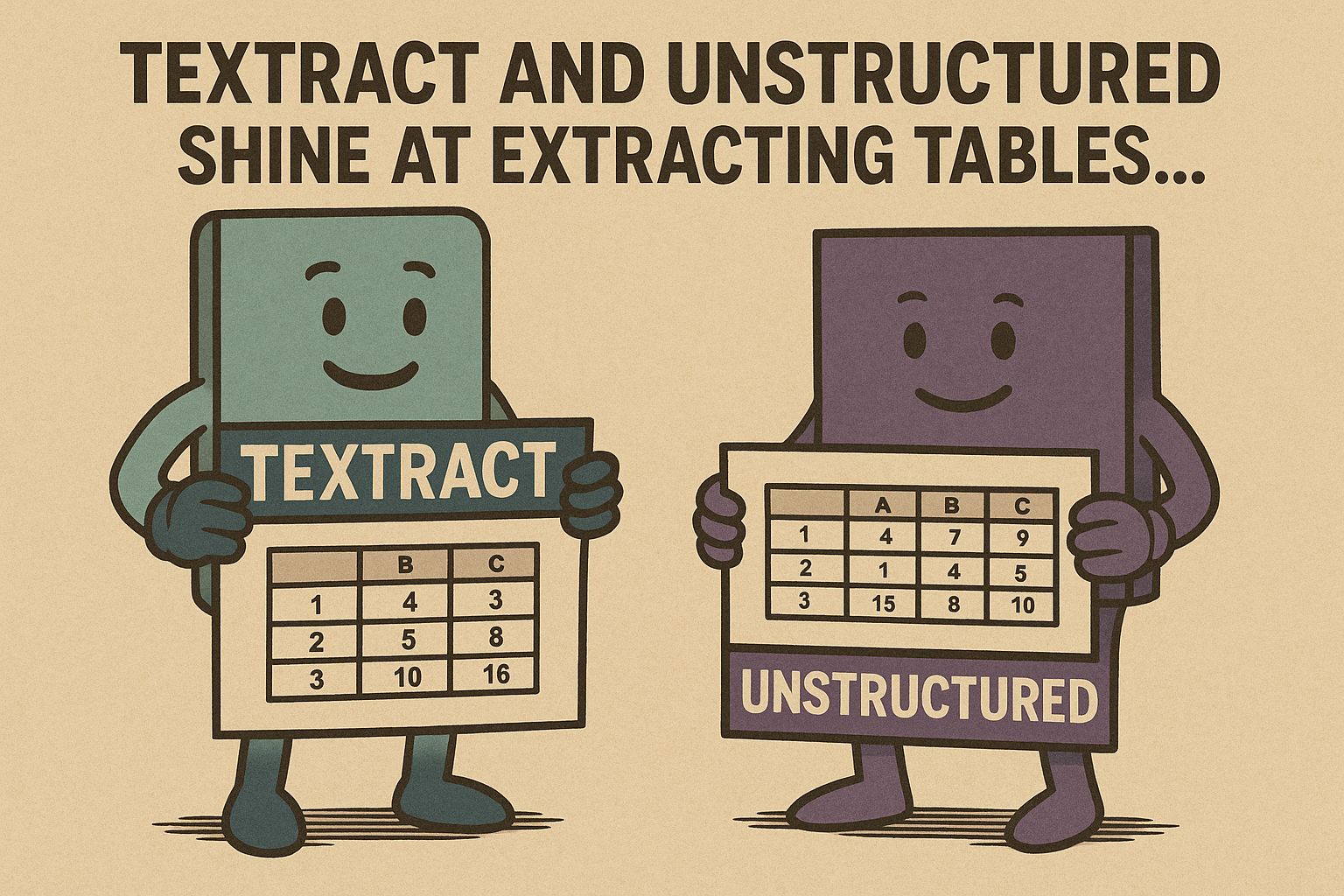April 30, 2025
When ChatGPT Can “See” Your Documents, Do You Still Need Specialized Tools like NLPs, Textract and Unstructured?
Imagine uploading a complex mortgage application to ChatGPT and asking, “Is this approved? What’s missing?” Or feeding a stack of medical records to Claude and requesting, “Summarize the patient’s treatment history.” A few years ago, these scenarios would have seemed like science fiction. Today, they’re increasingly possible. But should they be your go-to solution?
The rapid advancement of Large Language Models (LLMs) with multimodal capabilities has created a watershed moment in document processing. These models can “see” and interpret images and documents, not just text.

As someone who’s watched this space evolve, I’ve been struck by a fundamental question many organizations are now asking: Do powerful generalist AI models like GPT-4o, Claude 3, and Gemini make specialized document processing tools obsolete? The answer isn’t as straightforward as tech headlines might suggest. Let’s break down this complex landscape and understand when to use what tool for maximum benefit.
The Three Contenders in Document Intelligence
Before diving into comparisons, let’s meet our primary players:
1. Specialized Document Extraction Tools

Tools like AWS Textract are purpose-built for specific document analysis tasks. Textract’s design philosophy centers on high-precision extraction of structured data. It’s engineered specifically to pull text, tables, and form data from documents with verifiable accuracy.
What makes Textract special is its focus on structure and verification. When it identifies text or a form field, it doesn’t just return the content. It provides confidence scores and precise coordinates showing exactly where that information appeared in the document. This might sound technical, but it matters enormously for automated systems that need reliability guarantees.
2. Document Preprocessing Ecosystems
The unstructured ecosystem (both its open-source library and commercial platform) serves a different but equally critical function. Think of it as the ultimate document translator.
Its superpower is ingesting virtually any document format you throw at it. This includes PDFs, Word docs, PowerPoints, emails, and HTML pages. It breaks them down into standardized, clean components ready for AI systems to work with. It doesn’t just extract text; it preserves the semantic structure by identifying paragraphs, titles, tables, lists, and more.
If you’ve ever tried to extract usable text from a messy PDF, you’ll appreciate why this matters. Raw extraction often produces jumbled, unusable content. The unstructured platform solves this “first mile” problem of document processing.
3. Multimodal Large Language Models
The new kids on the block—GPT-4o, Claude 3/3.5, and Gemini models—have dramatically expanded what’s possible with document understanding. These models can process images and documents directly, “seeing” their layout and content simultaneously.
More impressively, they combine this visual understanding with deep reasoning capabilities. They don’t just extract information. They can interpret it, answer questions about it, summarize it, and even perform complex reasoning tasks using the document’s content.
Recent advances in context length are equally groundbreaking. Models like Claude 3 (with 200,000 token windows) and Gemini 1.5 (with up to 1-2 million tokens) can theoretically process entire books in a single prompt. This was unimaginable just a year ago.
The Surprising Truth: It’s Not About Replacement
After diving deep into how these technologies perform in real-world scenarios, I’ve reached a conclusion that might surprise you: the future isn’t about one technology replacing another—it’s about strategic integration. The most effective document intelligence systems today are hybrid approaches that use each technology’s strengths. Here’s what each excels at:
When Specialized Tools Shine
AWS Textract remains unmatched when:
- Accuracy is non-negotiable: For mission-critical extraction where errors could have serious consequences (think financial data, healthcare forms, or legal documents), specialized tools often provide superior reliability.
- Verifiability matters: Textract’s confidence scores allow you to programmatically identify when human review might be needed. This is a critical capability for automated systems.
- Complex structured data needs precise extraction: When dealing with intricate tables or dense forms where spatial relationships are crucial, specialized tools often maintain structure more reliably.
A banker processing mortgage applications or an insurance company handling claims forms will still find tremendous value in these specialized capabilities. This remains true even in an LLM-powered world.
When the unstructured Platform Proves Essential
The unstructured ecosystem becomes indispensable when:
- Format diversity is overwhelming: If you’re dealing with thousands of documents across dozens of formats, having a standardized ingestion layer saves enormous headaches.
- You’re building RAG systems: For Retrieval-Augmented Generation—where LLMs are enhanced with specific document knowledge—having clean, well-structured chunks of text with preserved metadata dramatically improves retrieval quality.
- Pre-processing at scale matters: Large-scale document operations require the kind of standardization and preparation that dedicated document processing tools excel at providing.
Many organizations have found that LLMs perform substantially better when fed the cleaned, partitioned, and properly chunked output from unstructured rather than raw document text.
When LLMs Take Center Stage
Multimodal LLMs prove their unique value when:
- Deep understanding is required: Need to answer complex questions that require reasoning across different parts of a document? LLMs excel here.
- Flexibility trumps rigid extraction: If you need to handle varied, unpredictable questions about documents rather than extract specific predefined fields, LLMs provide unmatched adaptability.
- You need natural language interaction: When the goal is enabling conversational engagement with document content, LLMs offer the most natural interface.
The Accuracy Reality Check
Let’s talk about the elephant in the room: accuracy. How do these approaches actually compare on performance?
The answer depends heavily on the specific task:
For basic OCR on clean documents: All three approaches perform reasonably well.
For noisy or handwritten text: Specialized OCR tools still generally outperform LLMs, particularly on difficult inputs, though LLMs can surprise with their capabilities on some handwriting.
For table extraction: This is where we see the biggest gap. Extracting complex tables remains challenging for LLMs. This is especially true for those with merged cells, nested structures, or unconventional layouts. They often make errors in structure preservation and numerical values. Specialized tools generally perform more reliably.

For key-value extraction from forms: LLMs can do quite well here, sometimes approaching specialized tools in accuracy. However, they lack the confidence scoring and may occasionally hallucinate values. This is a serious concern for automated processing.
A critical distinction worth noting: specialized tools provide explicit confidence scores for their extractions, allowing for programmatic reliability assessment. LLMs typically don’t offer this granular insight into which parts of their extraction might be less reliable.
The Smart Workflow: Complementary, Not Competitive
The most enlightened organizations aren’t asking “which tool should we use?” but rather “how should we combine these tools for optimal results?”
A common pattern emerging in sophisticated document systems looks like this:
- Use unstructured for initial document ingestion and preprocessing, transforming diverse formats into clean, structured components.
- Use Textract for high-fidelity extraction of critical structured data like complex tables or regulated forms where accuracy verification matters.
- Employ LLMs for understanding, interpretation, and flexible interaction with the prepared content. This includes answering questions, generating summaries, or providing insights.
This pipeline approach combines the specialized accuracy of extraction tools, the standardization power of preprocessing platforms, and the interpretive intelligence of LLMs into a solution greater than the sum of its parts.
Cost Considerations: The Numbers Game
The economics of document processing matter tremendously at scale. Here’s how the approaches compare:
AWS Textract uses a pay-per-page model, with costs varying based on features used. Basic OCR might cost around $1.50 per 1,000 pages, while advanced features like form and table extraction can range from $50-70+ per 1,000 pages.
The unstructured platform also follows a pay-per-page model, with pricing tiers based on processing complexity. Basic processing might cost $1-2 per 1,000 pages, while advanced processing with their high-resolution or VLM (Vision Language Model) pipelines might range from $10-30+ per 1,000 pages.
Multimodal LLMs follow a token-based pricing model (counting both input and output). The cost varies dramatically between models. Processing documents with images is particularly expensive in token terms. It’s potentially much higher than per-page pricing of specialized tools for high-volume operations.
For large-scale, standardized document processing tasks, specialized tools often prove more economical. For smaller volumes or tasks requiring deep understanding, LLMs might offer better value despite higher per-document costs.
The Future: Evolution, Not Revolution
Where is document AI headed? The lines between these technologies will likely blur further:
- LLMs will continue improving on structured extraction tasks, potentially challenging specialized tools in more scenarios.
- Specialized tools will increasingly integrate LLM capabilities for more flexible interaction while maintaining their core strengths.
- Pipeline architectures combining multiple technologies will become more seamless and accessible.
However, the fundamental need for verifiable accuracy in critical applications suggests specialized extraction tools will keep their importance. Similarly, the persistent challenge of diverse document formats provides a continuing role for robust preprocessing solutions.
Conclusion: Choose Your Tools Wisely
The document AI landscape isn’t a winner-takes-all scenario. Each technology brings unique capabilities that solve specific challenges in the document understanding journey.
For organizations facing document processing challenges, the key questions to ask are:
- How critical is absolute accuracy and verification for your use case?
- What volume of documents are you processing?
- How diverse are your document formats?
- What level of understanding and reasoning do you need to apply to the content?
- Do you need automated processing or interactive question-answering?
Your answers to these questions guide your technology choices. In many cases, you’ll find that a thoughtfully integrated approach delivers the optimal balance of accuracy, efficiency, and insight. This approach combines specialized extraction, document preprocessing, and LLM intelligence.
The document AI revolution isn’t about one technology making others obsolete—it’s about orchestrating these powerful tools to unlock the full potential of your document data.
What document processing challenges is your organization facing? Have you experimented with hybrid approaches? Share your experiences in the comments below.
- Amazon Textract: Automatically extract printed text, handwriting, layout elements, and data from any document
- The unstructured platform: ETL for Gen AI Data
About the Author
Rick Hightower is a AI professional with a specialized certification from Stanford University’s Professional Data Science Program. With extensive experience in AI and document processing technologies, Rick combines academic expertise with practical industry knowledge to provide insights into the evolving landscape of AI technologies and their real-world applications.
If you want to learn more check out this book.
TweetApache Spark Training
Kafka Tutorial
Akka Consulting
Cassandra Training
AWS Cassandra Database Support
Kafka Support Pricing
Cassandra Database Support Pricing
Non-stop Cassandra
Watchdog
Advantages of using Cloudurable™
Cassandra Consulting
Cloudurable™| Guide to AWS Cassandra Deploy
Cloudurable™| AWS Cassandra Guidelines and Notes
Free guide to deploying Cassandra on AWS
Kafka Training
Kafka Consulting
DynamoDB Training
DynamoDB Consulting
Kinesis Training
Kinesis Consulting
Kafka Tutorial PDF
Kubernetes Security Training
Redis Consulting
Redis Training
ElasticSearch / ELK Consulting
ElasticSearch Training
InfluxDB/TICK Training TICK Consulting

